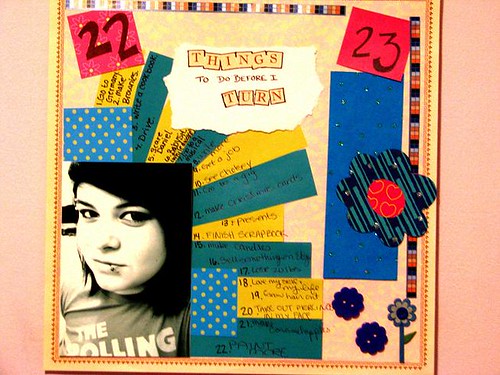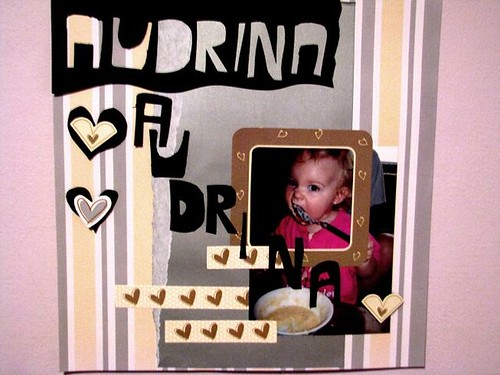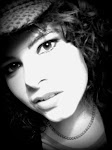Been feeling kind of scrappy..
I've been scrapbooking, I find it really helps me with stress and worrying. You wouldn't think I am a stressful person but I have alot of health problems and I tend to get stressed out whether I notice or not.
Anyhow check out these pages I've done!!



Here is a little information about my condition.
Information on hidradenitis suppurativa
HS FOUNDATIONhttp://www.hs-foundation.org/
INFORMATION:
Hidradenitis Suppurativa
Hidradenitis Suppurativa (HS) is an uncommon chronic inflammatory skin condition.It effects inverse areas of the body, top of inner thighs, bottom, genitals, armpits, under the breasts in women and less commonly the stomach, hair line and behind the ears. The symptoms of Hidradenitis Suppurativa vary greatly, it can be as slight as black heads and pimples or as serious as large draining lesions, growing to the size of golf balls. It has been suggested that HS may not be as rare as believed, but that people are hesitant to come forward through shame and embarrassment. Also the figures are low through lack of accurate diagnosis.Very little research has been done into Hidradenitis Suppurativa. It is known as an 'orphan' illness, which means, because it is considered rare there are no pharmaceutical companies that have taken up the challenge to find a decent treatment or cure. What we do know however, is that it is caused by the tendency of the appocrine hair follicle to become blocked. The question now is why? HS has been linked with auto immune disorders, it also has been found to have a genetic link. HS is more common in women, and seems to be effected by the hormones, although no exact pattern has emerged. As with many skin disorders, HS symptoms are increased by stress.
The three clinical stages of Hidradenitis Suppurativa :
Stage 1: Single or multiple abscesses form, without sinus tracts and cicatrization (scar formation)
Stage 2: Recurrent abscesses form, with tract formation and cicatrization. There may be single or multiple widely separated lesions.
Stage 3: Diffuse or near-diffuse involvement or multiple interconnected tracts and abscesses are observed across the entire area
It has been reported that as many as 80% of HS sufferers are diagnosed as clinically depressed. Depression is common amongst people who have to live in chronic pain. It can be treated with medication, but to cure the depression completely the reason for the depression must be removed. As there is no known cure for HS, this is not possible.
Diagnosis of Hidradenitis Suppurativa
If you have more than three boils in any one year, you should visit your Medical Practitioner. Boils can be a symptom of many illnesses and your doctor should test you for these. The diagnosis of Hidradenitis Suppurativa generally comes from the dermatologist, and is made from observing the areas where the boil-like lesion are, and the common presence of black heads and scarring.It is easily diagnosed if the dermatologist is familiar with the skin disorder.
Medical Treatments for Hidradenitis Suppurativa
There is not a single treatment that has been developed specifically for Hidradenitis. Therefore active involvement in choosing treatment and research is advisable. What may work for one patient, may be detrimental to another. Although HS is not Acne, the symptoms are sometimes similar and Dermatologists are keen to suggest Acne treatments, which have been proved to be ill-effective.Here is a list of the current treatments that may be offered to HS patients:
Antibiotics, (commonly tetracyclines) long term as a preventive measure, and short term (typically Ciprofloxicillin) for secondary infections. Many of these antibiotics react badly with sunlight and alcohol, and can cause nausea and bowel problems.
High-dose systemic steroids for their inflammatory effect.
Birth control Pills, as a measure to balance hormones.
Retinoids have been used with limited results.
Surgical treatments for Hidradenitis Suppurativa
Stage 1: May need incision and drainage
Stage 2: recurring lesions can be surgically removed along with any connecting tracts. Secondary healing is found to be most effective. There is a 50% chance of reoccurrence.
Stage 3: As the disease progresses, skin grafts and plastic surgery may be needed because of poor healing.
Radiotherapy is a treatment that is starting to be used again for HS.A recent study by Frochlich et al in Germany reported complete relief in 38% of patients, 40% dramatically improved and 2% had no effect. There were no reported complications, associated with the radiation.






0 comments:
Post a Comment